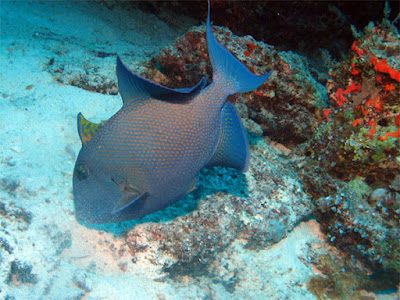My strapline says: scribbler, scuba diver and unrepentant
vagabond, so I thought it was high time I told you something about my scuba
diving experiences. Here is a little tale about the unicorns of the underwater
world…
 |
| Blue Triggerfish |
 |
| Frogfish |
The first time someone mentioned unicornfish I was
intrigued. Unicornfish? Surely the stuff of legends and fairytales! Of course
the reason for this name is more prosaic. Unicornfish have a protrusion between
their eyes, some more obvious than others.
 |
| Spotted Unicornfish |
I have to confess to feeling somewhat disappointed when I
identified my first unicornfish. Visions of endearing fish in My Little Pony
colours were shattered.
Drab in colour, it is the ‘horn’ that makes
this fish recognisable rather than its ‘plumage’.
So, I ignored unicornfish in favour of the flamboyant and
flirtatious strumpets of the fish world. I allowed myself to be diverted by
multi-coloured parrotfish, cute anemonefish - or clownfish - decked out in orange and white, delicate butterflyfish, angelfish and strangely angular boxfish. And who wouldn’t be
seduced by the Many Spotted Sweetlips with its Angelina Joliesk-pout?
 |
| Spinecheek Anemonefish |
 |
| Common Boxfish |
 |
| Many Spotted Sweetlips |
Yet, the unicornfish had something up their metaphoric fishy
sleeves that would knock the others’ behaviour into a cocked hat… their curiosity
of divers and our bubbles.
Pause for any length of time around unicornfish and they’ll
hover above you in your stream of bubbles. There is something enormously
appealing about any wild creature that is willing to interact.
 |
| Waiting for the unicornfish |
Now, whenever I spotted unicornfish on a dive, I would wait
to see whether they would approach and hang out in my bubbles. Whenever they
did, their demeanour reminded me of those Japanese macaques – you know the ones
that sit in the hot water pools with sleepy-eyed, stoned expressions?
 |
| Humpback Unicornfish |
The last time I saw unicornfish I was diving in The
Maldives. One bold individual hovered just above my head, enjoying my bubbles.
I reached out reflexively, as I often do. It’s a futile, harmless gesture
because no fish will tolerate human contact. On this occasion, the unicornfish
stayed put and allowed my fingers to brush, ever so softly, against his
surprisingly velvety skin.
 |








